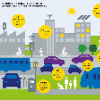Smart cities today can utilize Vehicular Delay Tolerant Networks (VDTN) to collect data from connected-objects in the environment for various delay-tolerant applications. They can take advantage of the available Intelligent Transportation Systems (ITS) infrastructures to deliver data to the central server. The system can also exploit multiple and diverse mobility patterns found in cities, such as privately owned cars, taxis, public buses, and trams, along with their Vehicle-to-Everything (V2X) communications capabilities. In the envisioned convergence between the ITS and V2X, we believe that a simple and efficient routing protocol can be deployed for the delay-tolerant data delivery, contrary to the implementation of optimized solutions that might be resource-demanding and difficult to standardize. In this paper, we analyzed the performances of four baseline VDTN routing protocols, namely: Direct Delivery, First Contact, Epidemic, and Spray & Wait, to understand their strengths and weaknesses. Our simulation results highlighted the trade-off between distinct approaches used by those protocols and pointed out some gaps that can be refined. This study provides new interesting ideas and arguments towards developing a simple, efficient, and high-performing routing protocol for data collection in smart cities.
翻译:智能城市今天可以利用汽车、出租车、公共公交车和电车等多种不同的移动模式,以及车辆到货物(V2X)的通信能力。在设想的ITS和V2X之间的汇合中,我们认为,可以部署简单而有效的路由协议,用于交付延迟容忍数据,这与执行可能需要资源和难以标准化的优化解决方案相反。在本文中,我们分析了四个基线VDTN路由协议的性能,即:直接交付、第一接触、流行病、喷雾和喷雾和等待,以了解它们的长处和弱点。我们的模拟结果突显了这些协议和V2X之间的不同做法之间的利弊,并指出了一些可以改进的漏洞。本研究报告为发展高效的城市的智能化协议收集提供了新的有趣想法和论据。


